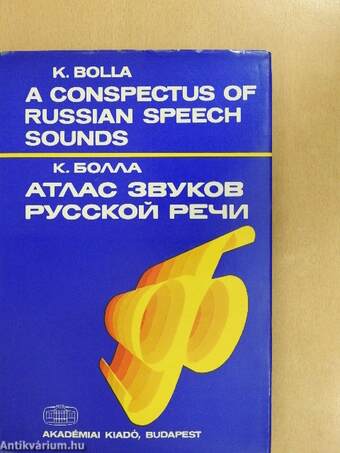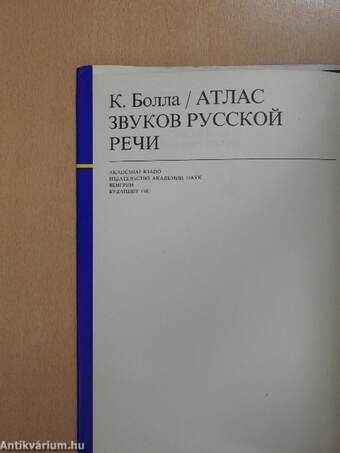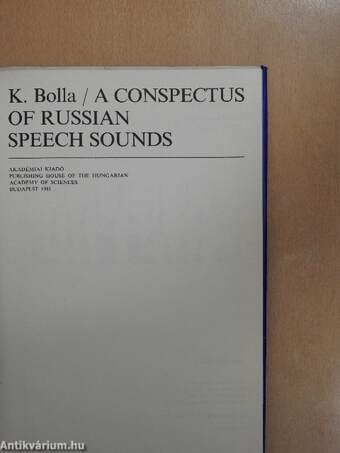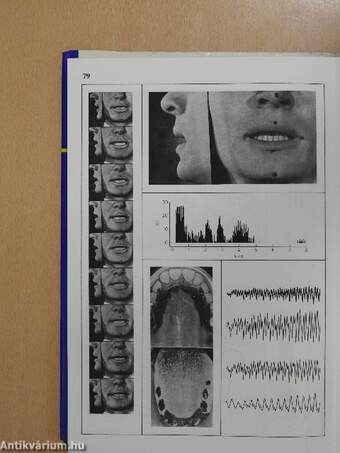1.117.303
kiadvánnyal nyújtjuk Magyarország legnagyobb antikvár könyv-kínálatát
A Conspectus of Russian Speech Sounds
| Kiadó: | Akadémiai Kiadó |
|---|---|
| Kiadás helye: | Budapest |
| Kiadás éve: | |
| Kötés típusa: | Vászon |
| Oldalszám: | 318 oldal |
| Sorozatcím: | |
| Kötetszám: | |
| Nyelv: | Angol Orosz |
| Méret: | 24 cm x 16 cm |
| ISBN: | 963-05-1502-4 |
| Megjegyzés: | Fekete-fehér fotókkal, ábrákkal. |
naponta értesítjük a beérkező friss
kiadványokról
naponta értesítjük a beérkező friss
kiadványokról
Előszó
FOREWORD
The present conspectus of Russian speech sounds is based on the material of the Hungarian-Russian contrastive phonetic research that I carried out in the years between 1966 and 1972.... Tovább
Előszó
FOREWORD
The present conspectus of Russian speech sounds is based on the material of the Hungarian-Russian contrastive phonetic research that I carried out in the years between 1966 and 1972. Since then, Hungarian-Russian phonetic investigations have gone far beyond the limits of the sound conspectus and have been incorporated in the phonetic research work which is being done at the Linguistics Institute of the Hungarian Academy of Sciences with the dual aim of producing a systematic descriptive monograph of the Hungarian sound system on the one hand, and a comprehensive comparison of Hungarian and Russian sound features on the other. A conspectus of speech sounds is inherently unsuited for the extensive demonstration and description of the dynamic mechanisms and functioning of speech. That is why I am presenting here only those observations from my research findings that concern speech sounds, and even those only to the degree absolutely necessary for the understanding of the diagrams and the sound plates.
The aim of the conspectus is to describe so-called speech sounds, i.e. the types of artic-ulatory-acoustic elements necessary for the phonic (viva voce) realization of linguistic communication in Russian. The 78 sounds presented in the conspectus have been obtained by a phonetic analysis of the Russian speech stream (sound strings). The speech sound is a unit having real existence within the continuum composed by the string of speech sounds. It is produced by the articulatory and perceived by the hearing organs of man in the communication process and as such, it can be recognized and characterized either as a quasi-identical complex of movements or as a quasi-identical complex of acoustic vibrations. We have registered a few sounds which occur less frequently, viz. at morpheme boundaries and in foreign words. Since they are not individual or optional sounds but ones that occur in definable situations, phonetic positions, within the sound string, we. have considered them as belonging to the 'building-blocks of Russian speech'.
The sound plates display the configurations of the articulatory organs necessary for the correct pronunciation of Russian speech sounds as well as the acoustic parameters of the latter. Since, instead of sounds uttered in isolation we have examined sound features which regularly recur in the typical phonetic positions (i.e. in the definite sound contexts) of meaningful linguistic elements, the sound diagrams also contain the data of typical sound transitions.
For the examination of the articulatory and acoustic parameters of sounds I have carried out instrumental experiments with several informants. Still, partly for lack of space, partly
7 Vissza
Tartalom
CONTENTS
LANGUAGE AND SPEECH 15
Stages of the speech chain (Speech stream) 16
THE MEANS AND METHODS OF SPEECH EXAMINATION 25
X-ray photography 25
Articulatory organs in the radiogram 26
Labiography 27
Measurement points of the photolabiograms 28
Palatography 28
The division of the palatogram 29
Linguography 29
The division of the linguogram 30
Oscillography 30
The technical data of the oscillogram 31
Spectrography 32
THE PHONETIC TRANSCRIPTION OF RUSSIAN SPEECH SOUNDS 44
The phonetic symbols and spelling of Russian speech sounds 47
The diacritic marks used in the phonetic transcription 56
THE ARTICULATORY AND ACOUSTIC FEATURES OF RUSSIAN SPEECH SOUNDS 60
The vowels in Russian 60
The phonetic positions of vowels 60
The quality and quantity of vowels 60
Monophthongs, di|phthongoids and triphthongoids 61
The Russian vowel system 62
Articulatory and acoustic features of Russian vowels 63
[a], [ai], [!a], [lai], [a] — [a], [a-], [ a], [-a ], [a] (Plates 2, 3, 4, 5, 23) 63
[0], [oi], [Jo], [W], [8] — [o], [o], [ o], [ o ], [o] (Plates 6, 7, 8, 9, 24) 64
[u], [ui], [!u], [iui], [u], [«1 — [y], [y], [ y], [-y], [y], [y] (Plates 19, 20, 21, 22, 30, 35) <.5
[fl. [*], [«"], [T], [»" 1, [r] — M. [wl. [h3]I. I"], [w31 , [h] (Plates 15, 16, 14, 27, 26, 31) 66
[1]. [']. [ie], [1], [!1 — W, [h], [Be],[H], [g] (Plates 17, 18, 29, 28, 33) 67
[e], [e], [e], [e], [i] — [a], [5], [e], [el, [5] (Plates 10, 11, 12, 13, 25) 68
[I], [»] — ?i>] W (Plates 34, 32) 69
The consonants in Russian 69
The phonetic positions of consonants 69
Palatalization and pharyngealization 70
Articulation of the tip of the tongue i\
Peculiarities of the narrowing 71
Types of configurations of articulatory organs 71
Articulatory and acoustic characteristics of Russian consonants 73
[p] — M (Plate 36) 73
[p'l — fn'] (Plate 37) 74
[b] — [6] (Plate 38) 74
[b'J — [6'] (Plate 39) 1 75
[t] — [t] (Plate 40) 76
[t'] — [t'] (Plate 41) 77
[d] — [a] (Plate 42) 77
[d'l — [fl'l (Plate 43) 78
[k] — [k] (Plate 44) 79
[k'] — [k'] (Plate 45) 79
[g] — [r] (Plate 46) 80
[g'l — [r'l (Plate 47) 81
[m], [iji] — [m] (Plate 48) 81
[m'J — [m'] (Plate 49) 82
[n] — [h] Plate 50) 83
[n'] —[h'] (Plate 51) 84
[f] — [4>] (Plate 52) 84
[f'] — [(J)'] (Plate 53) 85
[v] — [b] (Plate 54) 86
[v'J — [b'J (Plate 55) 86
[s] — [c] (Plate 56) 87
[s'J — [c'j (Plate 57) 88
[z] — [3] (Plate 58) 88
[z'] — [3'] (Plate 59) 89
[fl. [J:] — M> [m:l (Plates 60, 62) 90
[3],'[5:] —M, [*:] (Plates 61,63) 91
[f:] —[111':] (Plate 64) 91
[5':]-[»':] (Plate 65) 92
[c] - Ixl (Plate 66) 93
[j], — Li], [!] (Plates 67, 68) 93
[x] — [x] (Plate 69) 94
[x'] — [x'] (Plate 70) 94
M - [y] (Plate 71) 95
[ts] — [u] (Plate 72) 96
[dz] — [A3] (Plate 73) 96
[ff ] - [h'] (Plate 74) 97
[dg] — [flic] (Plate 75) 98
[r] — [p] (Plate 76) 99
[r'] — [p'l (Plate 77) 99
[t] — [jt] (Plate 78) 100
m — [JI'1 (Plate 79) 101
BIBLIOGRAPHY 149
FIGURES (1-12) 151
THE SOUND PLATES OF RUSSIAN SPEECH SOUNDS (1-79) 161
Témakörök
K. Bolla
K. Bolla műveinek az Antikvarium.hu-n kapható vagy előjegyezhető listáját itt tekintheti meg: K. Bolla könyvek, művekMegvásárolható példányok
Nincs megvásárolható példány
A könyv összes megrendelhető példánya elfogyott. Ha kívánja, előjegyezheti a könyvet, és amint a könyv egy újabb példánya elérhető lesz, értesítjük.








